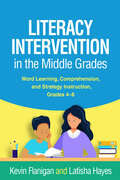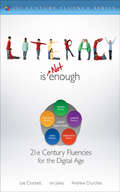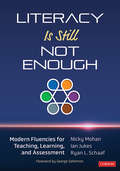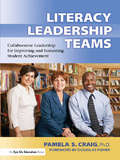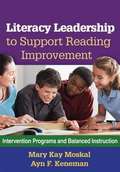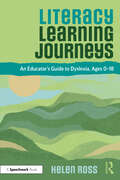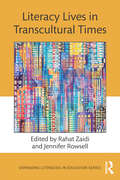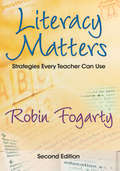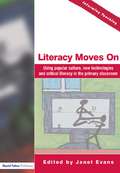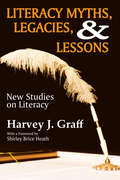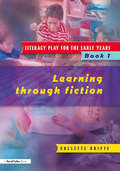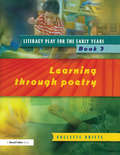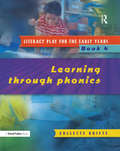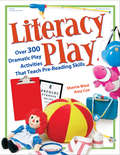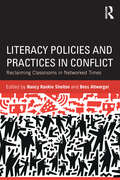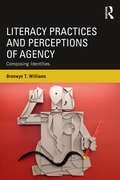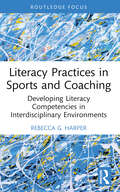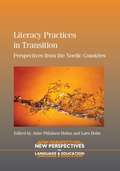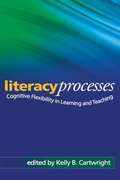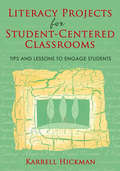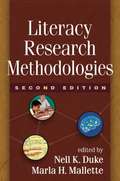- Table View
- List View
Literacy Intervention in the Middle Grades: Word Learning, Comprehension, and Strategy Instruction, Grades 4-8
by Dr. Kevin Flanigan Dr. Latisha HayesNo two students in grades 4–8 are identical, and many struggle with literacy for different reasons. Using a teacher-friendly, hands-on approach, this eminently practical book walks educators through the nuts and bolts of literacy intervention in the middle grades. Highlights include &“North Star&” principles to orient instruction, an assessment flowchart, and extended case studies of three middle-grades learners. The book offers evidence-based intervention practices for targeting specific literacy components, including word recognition, fluency, vocabulary, and comprehension. Teachers are guided to plan structured but flexible interventions that promote literacy growth and engagement. Sample lesson plans and clear, engaging figures illustrate how to make literacy intervention work for all students.
Literacy Is NOT Enough: 21st Century Fluencies for the Digital Age
by Ian Jukes Lee Crockett Andrew ChurchesHow to upgrade literacy instruction for digital learners Educating students to traditional literacy standards is no longer enough. If students are to thrive in their academic and 21st century careers, then independent and creative thinking hold the highest currency. The authors explain in detail how to add these new components of literacy: Solution Fluency Information Fluency Creativity Fluency Collaboration Fluency Students must master a completely different set of skills to succeed in a culture of technology-driven automation, abundance, and access to global labor markets. The authors present an effective framework for integrating comprehensive literacy or fluency into the traditional curriculum.
Literacy Is Still Not Enough: Modern Fluencies for Teaching, Learning, and Assessment
by Ian Jukes Nicky Mohan Ryan L. SchaafModern fluencies provide a platform for authentic teaching, learning, and assessment While reading, writing, and arithmetic remain important, they are no longer enough. For learners to thrive, they must move beyond traditional literacies to modern fluencies—the unconscious mental processes that are learned, adapted, and applied in the context of real-world problems and challenges. In this book, the authors unpack the fluencies (solution, information, creativity, communication, collaboration, and global citizenship) to reflect the relentless social, cultural, and economic shifts of modern times. Practical resources are presented alongside: Authentic Unit Plan Exemplars for each fluency Assessment rubric examples Discussion questions Learners today must master an entirely different set of essential skills and knowledge needed to succeed than previous generations. This book provides a practical framework for integrating new fluencies into traditional curriculum.
Literacy Is Still Not Enough: Modern Fluencies for Teaching, Learning, and Assessment
by Ian Jukes Nicky Mohan Ryan L. SchaafModern fluencies provide a platform for authentic teaching, learning, and assessment While reading, writing, and arithmetic remain important, they are no longer enough. For learners to thrive, they must move beyond traditional literacies to modern fluencies—the unconscious mental processes that are learned, adapted, and applied in the context of real-world problems and challenges. In this book, the authors unpack the fluencies (solution, information, creativity, communication, collaboration, and global citizenship) to reflect the relentless social, cultural, and economic shifts of modern times. Practical resources are presented alongside: Authentic Unit Plan Exemplars for each fluency Assessment rubric examples Discussion questions Learners today must master an entirely different set of essential skills and knowledge needed to succeed than previous generations. This book provides a practical framework for integrating new fluencies into traditional curriculum.
Literacy Leadership Teams: Collaborative Leadership for Improving and Sustaining Student Achievement
by Pamela CraigIn Literacy Leadership Teams: Collaborative Leadership for Improving and Sustaining Student Achievement, Pamela Craig, a veteran English teacher and a vice-president of the Florida Council of Teachers of English, focuses on practical ways for school leaders to establish school-based literacy leadership teams. She carefully outlines each step of the process so that readers will be able to create and sustain literacy leadership teams at their own schools. Craig provides insights and tools designed to bring teachers, administrators, and other members of the school community together to set and achieve goals for improving student achievement in literacy.
Literacy Leadership to Support Reading Improvement
by Mary Kay Moskal Ayn KenemanPacked with vivid examples from actual schools, this book explores specific ways that literacy leaders can partner with teachers to meet all students' instructional needs. It provides a range of research-based strategies for implementing effective instruction in a response-to-intervention framework. It also describes innovative interventions--including schoolwide programs and family and community initiatives that promote success for struggling readers. Practical ideas are presented for engaging particular populations, such as boys and middle and high school students, and for supporting teachers' professional development. Eight reproducible handouts and forms can be downloaded and printed in a convenient 8 1/2" x 11" size
Literacy Learning Clubs in Grades 4-8: Engaging Students across the Disciplines
by Heather Kenyon CaseyLiteracy learning clubs are highly motivating small-group collaborations that can improve tweens' and teens' academic achievement, support their social-emotional development, and increase their enjoyment of reading and writing. This book explains the research basis for the author's approach and offers practical instructions for implementation in English language arts, social studies, science, and mathematics classrooms, illustrated with detailed case examples. Links to the Common Core State Standards are identified, and multimodal methods and new literacies emphasized throughout. User-friendly features include end-of-chapter reflection questions and suggested activities. The Appendix provides reproducible planning forms and handouts that can be downloaded and printed in a convenient 8 1/2" x 11" size.
Literacy Learning Journeys: An Educator’s Guide to Dyslexia, Ages 0-18
by Helen RossAs educators, we want to help our learners flourish during their time with us, both academically and socially. However, many dyslexic children and young people experience substantial barriers to accessing the curriculum which can impact both their academic progress and overall wellbeing. This easy-to-read book equips educators with essential knowledge and practical guidance to ensure that all dyslexic students can access the curriculum effectively and fully express their ideas, creativity and understanding. Drawing on research and the author’s extensive experience, the book includes: A comprehensive introduction to dyslexia and an overview of what it can look like at different stages of education, from the Early Years to Year 11 and beyond Practical, evidence-based strategies to help students with dyslexia and specific literacy difficulties engage with the curriculum, make progress and enjoy learning across their entire educational journey A wealth of case studies and interview excerpts from students, parents and teachers to contextualise their experiences Reflection prompts and exercises to help you consider your own learners so that you can draw on strategies presented in this book as part of your own practice Literacy Learning Journeys champions kindness and empathy and takes a positive approach to dyslexia to help children and young people thrive in the mainstream classroom. With easy to dip in and out chapters and signposting to further reading and resources, it is essential reading for teachers, teaching assistants and anyone working with learners with dyslexia.
Literacy Learning in the Early Years
by Caroline Barratt-PughChildren's early experiences of literacy have a major influence on how they continue to learn as they grow older. Children enter early childhood programs and school with a wealth of knowledge and understandings of literacy. It is critical that early childhood professionals and teachers recognise and build on this learning.Literacy Learning in the Early Years offers a practical introduction to literacy issues for early childhood professionals and teachers working with children aged 0-8, in childcare, preschool and school contexts.The authors take a socio-cultural approach to literacy learning, emphasising the importance of understanding the various contexts in which young children are involved in literacy practices. They explore a range of literacy issues that early childhood professionals and teachers are facing in the 21st century. These issues include the role of play in literacy learning, how to use information communication technologies with young children and ways of introducing critical literacy. Literacy is understood broadly and readers are encouraged to explore a range of print and other media with children.With chapters from both Australian and UK authors Literacy Learning in the Early Years is an ideal professional reference and student text.a very useful introductory text to literacy development in early childhood. It is clearly written and accessible to the wide range of professionals working with young children as well as to teachers and parents. It will be a valuable text in training at initial and in-service levels on a wide range of courses.Lesley Abbott, Professor of Early Childhood Education, Manchester Metropolitan Universitythis well written, comprehensive book combines many practical examples of learning to do literacy and suggestions for action, and all the while engages the reader with questions and starting points for reflection.Susan Hill, Associate professor, The Centre for Studies in Literacy, University of South Australia
Literacy Lessons, K–8: Connecting Activities to Standards and Students to Communities
by Helen I. HoffnerThese classroom-ready lesson plans—complete with literature lists, directions, sample forms, assessments, and adaptations—connect literacy learning with students' lives and the community.
Literacy Lives in Transcultural Times (Expanding Literacies in Education)
by Jennifer Rowsell Rahat ZaidiCombining language research with digital, multimodal, and critical literacy, this book uniquely positions issues of transcultural spaces and cosmopolitan identities across an array of contexts. Studies of everyday diasporic practices across places, spaces, and people’s stories provide authentic pictures of people living in and with diversity. Its distinctive contribution is a framework to relate observation and analysis of these flows to language development, communication, and meaning making. Each chapter invites readers to reflect on the dynamism and complexity of spaces and contexts in an age of increasing mobility, political upheaval, economic instabilities, and online/offline landscapes.
Literacy Matters: Strategies Every Teacher Can Use
by Robin J. FogartyThe author defines 15 literacy approaches, with research and best practices associated with each strategy, to teach literacy and comprehension across all grade levels and content areas.
Literacy Moves On: Using Popular Culture, New Technologies and Critical Literacy in the Primary Classroom
by Janet EvansThis book looks at the changing nature of literacy and at the way in which new and different literacies are emerging in the first part of the 21st century. It considers how children are shaping and being shaped by these changes, it also looks at how teachers need to bridge-the-gap between children's out of school interests and school based curriculum demands. This edited collection, which features chapters by international experts and voices in the field, aims to: Take a closer look at (and demystify) some of the influences on literacy in the 21st century e.g. popular culture, multi-modal texts, email, text messaging and critical literacy. Enhance teachers' awareness of these developments and show how they can use them to improve the literacy skills of their pupils. Show, through the Implications for Practice sections, how teachers can find different but straightforward ways of linking children's personal, out-of-school interests with the demands of the school curriculum.
Literacy Myths, Legacies, and Lessons: New Studies on Literacy
by Harvey J. Graff Shirley Brice HeachIn his latest writings on the history of literacy and its importance for present understanding and future rethinking, historian Harvey J. Graff continues his critical revisions of many commonly held ideas about literacy. The book speaks to central concerns about the place of literacy in modern and late-modern culture and society, and its complicated historical foundations.Drawing on other aspects of his research, Graff places the chapters that follow in the context of current thinking and major concerns about literacy, and the development of both historical and interdisciplinary studies. Special emphasis falls upon the usefulness of "the literacy myth" as an important subject for interdisciplinary study and understanding. Critical stock-taking of the field includes reflections on Graff's own research and writings of the last three decades, and the relationships that connect interdisciplinary rethinking and the literacy myth.The collection is noteworthy for its attention to Graff's reflections on his identification of "the literacy myth" and in developing LiteracyStudies@OSU (Ohio State University) as a model for university-wide interdisciplinary programs. It also deals with ordinary concerns about literacy, or illiteracy, that are shared by academics and concerned citizens. These nontechnical essays will speak to both academic and nonacademic audiences across disciplines and cultural orientations.
Literacy Play for the Early Years Book 1: Learning Through Fiction
by Collette DrifteThis series of books uses fiction, non-fiction and poetry texts, as well as phonics, as a basis to help young children in the Early Years develop their literacy skills. It brings together the early learning goals of the foundation stage and the national literacy strategy objectives, using structured play, games and fun activities to put across the relevant teaching points in an enjoyable way, while simultaneously nurturing a love of literature. Each book presents structured activities based around suggested focus texts. To help practitioners save time in planning and organizing, the materials needed and the preparation required for each session are described in detail. The activities have been designed to cater to different achievement levels, and can be adapted or added to according to the needs of individual children and settings. Follow-up activities are also suggested, to bring in wider aspects of the Early Learning Goals and the NLS objectives. Elements of this book include exploring well-loved traditional stories and quality familiar modern stories by established authors; using the texts as a basis to focus on specific literacy goals and objectives; using the texts as a stimulus for games and play activities that help to teach literacy skills; planning and preparation for each literacy session, including materials needed and scripted sessions; ideas for working and playing with the whole group and smaller groups to consolidate the literacy skill; and extension ideas and activities.
Literacy Play for the Early Years Book 3: Learning Through Poetry
by Collette DrifteThis series of books uses fiction, non-fiction and poetry texts, as well as phonics, as a basis to help young children in the Early Years develop their literacy skills. It brings together the early learning goals of the foundation stage and the national literacy strategy objectives, using structured play, games and fun activities to put across the relevant teaching points in an enjoyable way, while simultaneously nurturing a love of literature. Each book presents structured activities based around suggested focus texts. To help practitioners save time in planning and organizing, the materials needed and the preparation required for each session are described in detail. The activities have been designed to cater to different achievement levels, and can be adapted or added to according to the needs of individual children and settings. Follow-up activities are also suggested, to bring in wider aspects of the Early Learning Goals and the NLS objectives. Elements of this book include exploring well-loved traditional stories and quality familiar modern stories by established authors; using the texts as a basis to focus on specific literacy goals and objectives; using the texts as a stimulus for games and play activities that help to teach literacy skills; planning and preparation for each literacy session, including materials needed and scripted sessions; ideas for working and playing with the whole group and smaller groups to consolidate the literacy skill; and extension ideas and activities.
Literacy Play for the Early Years Book 4: Learning Through Phonics
by Collette DrifteThis series of books uses fiction, non-fiction and poetry texts, as well as phonics, as a basis to help young children in the Early Years develop their literacy skills. It brings together the early learning goals of the foundation stage and the national literacy strategy objectives, using structured play, games and fun activities to put across the relevant teaching points in an enjoyable way, while simultaneously nurturing a love of literature. Each book presents structured activities based around suggested focus texts. To help practitioners save time in planning and organizing, the materials needed and the preparation required for each session are described in detail. The activities have been designed to cater to different achievement levels, and can be adapted or added to according to the needs of individual children and settings. Follow-up activities are also suggested, to bring in wider aspects of the Early Learning Goals and the NLS objectives. Elements of this book include exploring well-loved traditional stories and quality familiar modern stories by established authors; using the texts as a basis to focus on specific literacy goals and objectives; using the texts as a stimulus for games and play activities that help to teach literacy skills; planning and preparation for each literacy session, including materials needed and scripted sessions; ideas for working and playing with the whole group and smaller groups to consolidate the literacy skill; and extension ideas and activities.
Literacy Play: Over 300 Dramatic Play Activities That Teach Pre-Reading Skills
by Amy Cox Sherrie WestChildren love to pretend, and dramatic play is the perfect environment for practicing and applying literacy concepts. Whether they decide to be firefighters, to open a pet store, or to have a tea party, children will increase their vocabulary, communicate with their friends, and learn to recognize environmental print - all important skills for pre-readers. Literacy Play is chock-full of creative dramatic play activities that teach important pre-reading skills while bringing children's imaginations to life!
Literacy Policies and Practices in Conflict: Reclaiming Classrooms in Networked Times
by Nancy Rankie Shelton Bess AltwergerCurrent U.S. school reform efforts link school success, student achievement, and teacher performance to standardized tests and narrowly prescribed curricula. How do test-driven, mandated curricula in urban school systems overtly and subtly impact teachers’ efforts to provide technologically advanced, challenging classroom environments that foster literacy development for all students? How do these federal policies affect instruction at the classroom level? The premise of this book is that, in order for teachers to confront and/or counteract the pressures placed on them from these policies, it is necessary to first understand them. This book takes a close look at the tensions that exist between federal mandates and contemporary literacy needs and how those tensions impact classroom practices. Providing a clear sociopolitical overview and analysis, it combines theoretical explanations with examples from current ethnographic research. Readers are challenged to (re)consider whether meeting test performance benchmarks should be the hallmark of school success when the goal of test performance supersedes the goal of producing highly literate, productive citizens of the future.
Literacy Practices and Perceptions of Agency: Composing Identities
by Bronwyn T. WilliamsIn this book, Bronwyn T. Williams explores how perceptions of agency—whether a person perceives and feels able to read and write successfully in a given context—are critical in terms of how people perform their literate identities. Drawing on interviews and observations with students in several countries, he examines the intersections of the social and the personal in relation to how and, crucially, why people engage successfully or struggle painfully in literacy practices and what factors and forces they regard as enabling or constraining their actions. Recognizing such moments and patterns can help teachers and researchers rethink their approaches to teaching to facilitate students’ sense of agency as writers and readers.
Literacy Practices in Sports and Coaching: Developing Literacy Competencies in Interdisciplinary Environments (Routledge Research in Literacy Education)
by Rebecca G. HarperThis book addresses the ways in which literacy skills, including both reading and writing instruction, are introduced, reinforced, reviewed, and refined in a sports or physical education setting.While there has been significant research that highlights the academic benefits of sports participation and the use of sports programming and units for literacy instruction in the classroom, there is limited research regarding the literacy practices that occur as a direct part of sports participation. This book addresses this crucial gap in the scholarship. The argument presented in this manuscript contends that a number of literacy skills and competencies are taught in and through a number of sports programs and explores how they are effectively and naturally integrated into structured athletics/sports programming. Addressing engagement with literacy skills and competencies in a unique setting, it provides a new lens from which readers can view reading and writing.This book will be of critical interest to scholars and researchers with interests in literacy education and sports education, as well as instructional coaches, sports coaches, literacy educators, health and physical education teachers, middle and secondary educators, and administrators.
Literacy Practices in Transition
by Lars Holm Anne Pitkänen-HuhtaLiteracy Practices in Transition explores the connections between local, situated literacy practices and global processes of mobility in the geographical space of the Nordic countries, an example of contemporary mobile societies. The detailed empirical analyses show how these connections affect individuals, practices and policies; how the global and local meet in discourses and practices and how people need to (re)negotiate their way in the complex and messy spaces in which they move. The volume challenges current trends in the global standardization of language and literacy education. Instead, it promotes the idea of literacy as a multiple, multilingual, multimodal and constantly contestable and negotiable phenomenon, which calls for the development of language and literacy education that is sensitive to the needs and experiences of the individual actors.
Literacy Processes
by Gedeon O. Deak Kelly B. CartwrightReading and writing instruction require individuals--both students and teachers--to flexibly process many kinds of information, from a variety of sources. This is the first book to provide an in-depth examination of cognitive flexibility: how it develops across the lifespan; its role in specific literacy processes, such as phonemic awareness, word recognition, and comprehension; and implications for improving literacy instruction and teacher education. The contributors include leading researchers in literacy, psychology, and cognitive development, who summarize the current state of the science and offer practical suggestions for fostering cognitive flexibility in learners of all ages.
Literacy Projects for Student-Centered Classrooms: Tips and Lessons to Engage Students
by Karrell HickmanMeets NCTE and IRA standards, offers guidelines for using the student-centered approach to literacy instruction, and presents four long-term research projects that encourage teamwork and creativity.
Literacy Research Methodologies, Second Edition
by Marla Mallette Nell DukeThe definitive reference on literacy research methods, this book serves as a key resource for researchers and as a text in graduate-level courses. Distinguished scholars clearly describe established and emerging methodologies, discuss the types of questions and claims for which each is best suited, identify standards of quality, and present exemplary studies that illustrate the approaches at their best. The book demonstrates how each mode of inquiry can yield unique insights into literacy learning and teaching and how the methods can work together to move the field forward. New to This Edition Significantly expanded covers 18 approaches instead of 13.Incorporates the latest methodological advances and empirical findings. Chapters on content analysis, research in digital contexts, mixed methods, narrative approaches, and single-subject experimental design.
